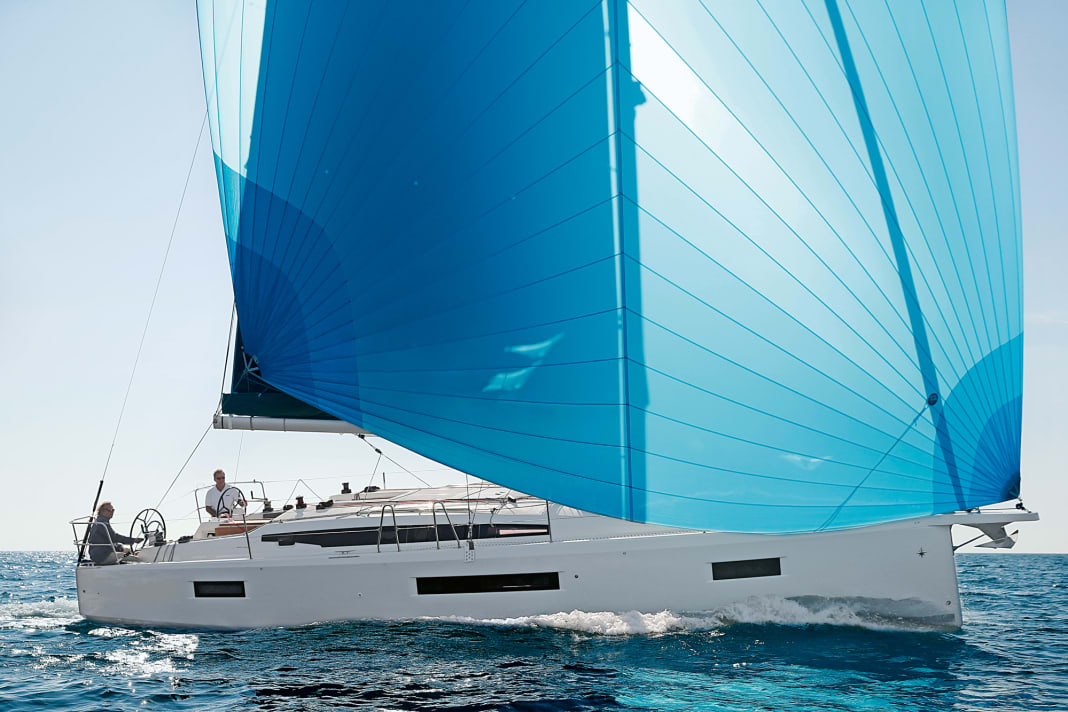





In this article:
Good ideas deserve to be honoured. This is what earned the Sun Odyssey 440, which made its debut in autumn 2017, the prestigious title of European Yacht of the Year 2018. The reason for the award was not least the completely new deck design at the time, which has since become an established term at Jeanneau: "walkaround cockpit". It goes without saying that this innovation can also be found on the Sun Odyssey 410, which was presented shortly afterwards.
The highlight: the side running decks drop from the centre of the ship to the stern to the level of the cockpit floor. This creates real channels between the coaming and the edge of the deck on both sides, providing the crew with barrier-free access to the foredeck without having to climb over the edge of the cockpit.
The idea was conceptualised by designer Philippe Briand in collaboration with the developers at Jeanneau and presented at the same time with the Sun Odyssey 440 and 490 models. In the meantime, however, the yacht builders in Les Herbiers have continued to work on the eighth generation of the cruising range; they have quietly developed a new, somewhat smaller boat for the twelve-metre class, which is in demand among owners and charterers. This time, however, the designer was not Briand, but Marc Lombard, Jeanneau's partner for the smaller and medium length segment.
At the time, the 410 replaced the Sun Odyssey 419, which had been added to the programme two years earlier as a revision of the 409. This in turn dated from 2010 and was highly successful, also winning Europe's Yacht of the Year. After almost eight years, Jeanneau felt the time had come for a new design in 2018.
As soon as the Sun Odyssey 410 was announced, the first two prototypes were already in the water. YACHT was the first trade magazine to go on board in Les Sables d'Olonne on the French west coast.
Barely visible asymmetry on the Sun Odyssey 410 makes the passage easier
The initial question was whether the walkaround concept on deck would work at all - because it is becoming increasingly difficult to realise with ever smaller dimensions. The 440, for example, offers 30 centimetres more room to manoeuvre in width alone.
Consequently, the crew on the 410 has to live with compromises. The cockpit is somewhat slimmer than on a boat of the same width with a conventional layout. Ultimately, however, this restriction is hardly a problem. There is still enough space in the cockpit for a rather bulky cockpit table with large fold-out side panels.
Only those who look closely can recognise that the table is not completely symmetrical and also appears to be mounted at a slight angle. With this trick, the shipyard has made it easier to pass through the cockpit. For the same reason, the companionway has also been moved four centimetres to port. Even at second glance, these asymmetries are hardly noticeable.
Walkaround on the Sun Odyssey 410: Good for manoeuvring, bad for the helmsman
In contrast, the walkaround concept makes significant concessions for the helmsman, who is left with a pitifully small seating area behind the wheel. Sitting sideways is hardly possible either, because the wires of the double-guided backstay restrict freedom of movement. The only practical and safe position is therefore to stand behind the wheel, which can be tiring on long strokes or in heavy seas.
On the other hand, the new cockpit design offers significant advantages for manoeuvring. To operate the winches, you can stand sideways in the deck recesses on the 410 and crank at a good height with plenty of power and visibility, which is no longer possible on many modern designs with winches concentrated aft. The helmsman is also able to reach the lines without having to give up control of the wheel. The manoeuvres also work perfectly in one-handed operation.
The sheets for the foresail and mainsail are led back over the coaming on both sides and are folded and stopped alternately when tacking and jibing. Anything that is not needed can be stored on the lowered running deck without getting in the way in the cockpit. The fact that halyards, reefing lines and trim lines are operated separately on the companionway helps to keep things organised and clear. This means that the cockpit remains largely unaffected by the functions for setting and trimming the sails.
Lots of volume in the bow, lots of space on deck
The walkaround solution is therefore sensibly implemented, apart from the restricted position of the helmsman. You just have to get used to the fact that you can get around the steering columns without any obstacles. The test showed that even the Jeanneau shipyard crew instinctively look for the short route over the coamings to get to the foredeck quickly. This is probably also due to the fact that the passageway aft is occupied by the helmsman on at least one side.
The Sun Odyssey 410's distinctive chines that extend all the way to the bow, a slightly negative stem and the wide stern with two rudder blades characterise her appearance. The reference to the current representatives in the ocean racing circus, such as the Class 40, is hard to overlook, even if the yachts there are much flatter. As the designer of numerous state-of-the-art racers, Marc Lombard can draw on a wealth of experience.
The extremely voluminous bow section of the Jeanneau with its almost vertically sloping flanks is particularly striking. This design feature also stems from the latest findings in the design of offshore racers and also has advantages for the expansion options below deck. A comparison proves this impressively: the deck area of the new ship is 13 per cent larger than that of its predecessor, the Sun Odyssey 419 - despite the same length and width.
The short keel of the test boat doesn't quite fit
In terms of design, the concept promises good sailing characteristics and considerable performance potential, which unfortunately could not be fully utilised in the test in winds of between 8 and 10 knots. Although the 410 cruises through the water quite swiftly at 5.6 knots, it tacks over a fairly large angle of around 100 degrees. Hervé Piveteau, product developer at Jeanneau, explains the poor height downwind with the short keel of the test boat; this only goes 1.62 metres deep instead of 2.17 metres. For testing purposes, the shipyard initially equips all prototypes with the weakest and heaviest configuration of the hull appendages. Piveteau assumes that the ship with the deeper L-keel and lead bomb should run at least five degrees higher.
The short keel doesn't really fit in with the equipment of the test boat anyway, which has the performance package at extra cost. This includes a mast that is around 65 centimetres higher, laminate sails with almost five square metres more surface area, a hydraulically trimmable backstay and halyards made of low-stretch Dyneema material.
Simple fittings that are easy to operate
Amazingly, the Sun Odyssey can carry the extra propulsion from the rig well thanks to its remarkable dimensional stability. She sails extremely stiffly on all courses and hardly leans more than 25 degrees, even if you deliberately want to force the heel. She also turns briskly and can be steered precisely downwind using the well-balanced steering. Light rudder pressure gives just the right amount of feedback.
Instead of a traveller, the Sun Odyssey 410 is fitted with a simple sheet triangle in front of the companionway to guide the mainsheet. The system is simple, light and inexpensive, but at the same time very effective because the main boom can be pulled to the centre of the boat when sailing close to the wind. Jeanneau has dispensed with the heavy and, over time, usually leaky rails and sheet carriages for the genoa's hoisting points. Instead, there are the equally easy-to-install, yet very efficient 3D haul points, which originate from ocean racing. These allow the angle of pull to be infinitely adjusted in all directions, although this requires a certain amount of experience and sensitivity.
Sensible cabin layout for the Sun Odyssey 410
The owner's cabin forward, two double cabins aft, plus a large bathroom with separate shower compartment - this is the usual standard for interior fittings in the twelve-metre class (see technical data and competitors on the following double page). Jeanneau's new 40-footer is no exception.
Due to the size and concept, there are few other layout alternatives. On all competitor yachts, an additional wet cell can be ordered in the foredeck on request and a spacious cockpit instead of the second double cabin aft. The boats from the large series do not offer much more freedom of choice, apart from the new and smaller Dufour 390, which offers three cabins and three heads compartments for the charter market. The Sun Odyssey 410 does not have this option, although the shipyard sells between 25 and 30 per cent of all yachts in the mid-length segment directly into the international charter business.
Multifunctional sofa
Instead, Jeanneau, the number 2 in the world, sets itself apart from the competition with other special features. Similar to its larger sister models of the current generation, the 410 has an unusual main cabin design. The large galley is closer to the main bulkhead than usual, but is designed as a large U rather than a long row. Jeanneau has also provided a day berth in the form of a chaise longue almost in the centre of the saloon, where you can lie down for a nap while underway.
The sofa bed can also be converted into a bunk in one easy step, although at 1.50 metres long, this is not enough for everyone. The saloon table can be folded out towards the centre sofa, allowing up to seven people to sit and eat together comfortably.
If an additional wet room is required in the foredeck, the shipyard does not install the berth in the centre of the room at the front, but transversely at the side. The berth dimensions remain unchanged, with a length of 2.00 by 1.50 metres, two people can sleep comfortably here. In the symmetrically arranged aft compartments, on the other hand, the berths are rather narrow with a width of 1.40 metres at shoulder height, at least compared to the size of the boat.
A relatively wide service channel between the compartments with openings to the on-board technology components and the shaft drive takes up a lot of space. In contrast, the accessibility of the steering mechanism in the aft peak is exemplary. Large maintenance hatches in the bulkhead allow easy access for inspection and maintenance.
Known shortcoming
It seems that the prototype we sailed was only completed under increased time pressure. There are still some unsightly flaws in the finishing on the boat: wide gaps, for example, or completely unfinished cut edges in the furniture. Improvements and more careful craftsmanship would be desirable for the start of series production.
As already criticised in the test of the Sun Odyssey 440, the floorboards of the smaller boat also squeak and creak considerably under load, which will not improve over time and can be annoying on cruises, especially at night. This has been a recurring theme in almost all YACHT tests of Jeanneau's touring yachts for many years now. And the problem unfortunately remains unresolved on the new boat. An annoying shortcoming, but one that could easily be remedied.
It can't be because the shipyard's costing is too high that it nonchalantly ignores this. The standard price for the 410 is 196350 euros, which is only a small surcharge of less than 4500 euros compared to the previous model. Compared to the competition, however, the Sun Odyssey is currently the most upmarket offering, even if the gap between it and its competitors remains small.
Successful transplantation
Jeanneau can operate so confidently on the market because the 410 is unrivalled. This is also, but not only, due to the innovative walkaround cockpit. All in all, its transplantation into the twelve-metre segment has been a success. And those who don't rate barrier-free access to the deck too highly will still find plenty of other unique selling points in the boat that appear attractive in their own right - the beefy, sporty-looking hull, for example, the extra living space and the unusual saloon design.
Interview with designer Marc Lombard
YACHT: Mr Lombard, the walk-around concept also works quite well in the cockpit of the 410. Can it be made even smaller?
Lombard: The task was quite difficult for the Sun Odyssey 410. But I think we managed it pretty well. It might be possible to go up to 36 feet with this cockpit design, but then we would certainly reach the limits of feasibility.
You have designed the boat with a slightly negative bow stem. More optics or also function?
Together with the long bowsprit, the inverted shape looks particularly sporty. We can save some weight because the deck is smaller with the same hull length. The impact on performance remains marginal.
In the new ship, the bow section is extremely voluminous and there is an overhang at the height of the waterline. Why is that?
The fullness at the front is primarily intended to compensate for the very wide stern and prevent the boat from diving too much over the bow in the wind. The overhang helps with this and also ensures good reactions because the boat no longer has to follow its stem and turns more easily. This is also an advantage when manoeuvring in the harbour, for example.
The wide bow offers more space for the interior fittings. Just a pleasant side effect?
No, the developments in form and function go hand in hand. In the past, the ratio between the volumes above and below the waterline was balanced, around 50:50. Today, the ratios are completely different: 80 per cent volume above and only 20 per cent below the water, perhaps even more extreme in some boats.
Measured values Sun Odyssey 410
Sailing performance, without drift and current
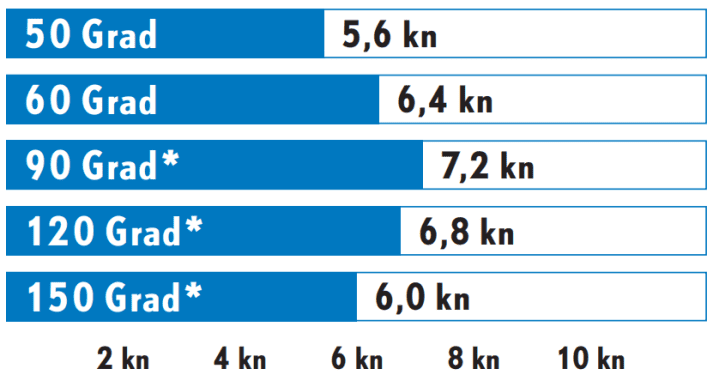
Wind speed: 8 kn (3 Bft.), wave height: swell approx. 0.5 metres
* With gennaker
Potential

The Tourer is built quite light. However, the sail carrying capacity remains moderate
1 Dimensionless number. Calculation: 2√S/3√V. The higher the value, the more sail area (S) the ship has in relation to the displacement (V).
Berth dimensions
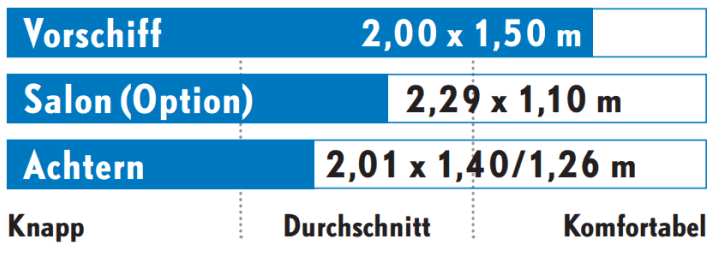
Standing height
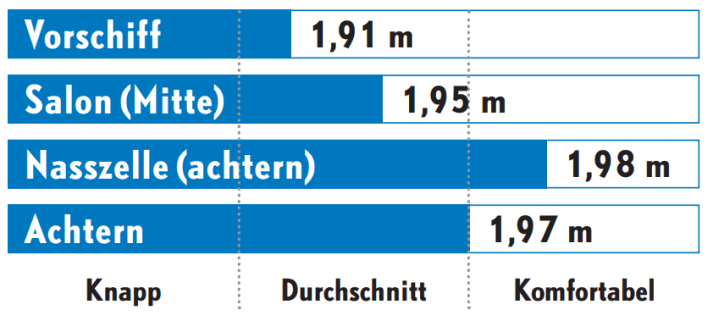
Sound pressure
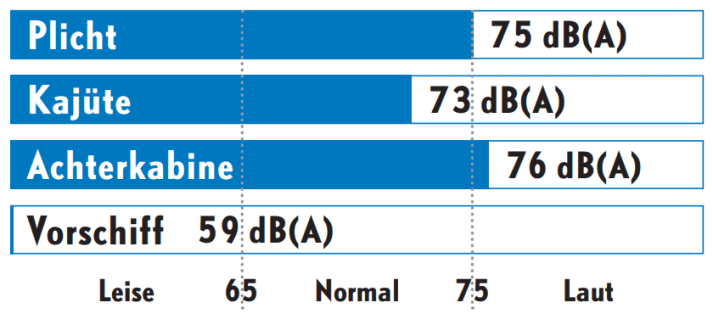
Measured at cruising speed (80 % of maximum speed): 7.5 kn, 2480 min -1
Technical data Sun Odyssey 410
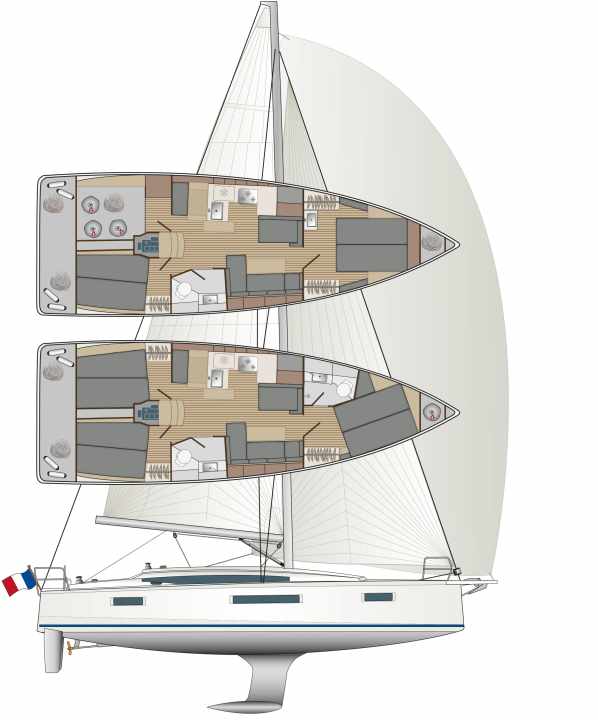
- Design engineer:Marc Lombard
- CE design category: A
- Torso length: 11,99 m
- Overall length incl. bowsprit:12,95 m
- Waterline length:11,71 m
- Width: 3,99 m
- Draught/alternative:2,17/1,62 m
- Theoretical torso speed:8.34 kn
- Weight:8,0 t
- Ballast/proportion:2,1 t/26 %
- Mast height above waterline:17,70 m
- Mainsail: 43,6 m2
- Furling genoa (110 %):36,8 m2
- machine (Yanmar): 29 kW/40 hp
- Fuel tank (plastic):195 l
- Fresh water tank (plastic): 330 l
- Holding tank (plastic): 80 l
Hull and deck construction
- Hull: GRP full laminate in manual support
- Deck:GRP sandwich construction built using the vacuum injection method. Floor assembly in vacuum infusion
Base price ex shipyard
276,556 euros gross incl. 19 % VAT (as at July 2023)
Shipyard
Chantiers Jeanneau, 85500 Les Herbiers (France); www.jeanneau.de
YACHT review Sun Odyssey 410
Exciting competitor for the popular twelve-metre class. With its unusual cockpit concept, modern hull and interesting layout below deck, Jeanneau is making its mark. The 410 is a comfortable cruising yacht and also has sailing potential
Design and concept
- + Innovative cockpit layout
- + Modern design approaches
- + Wide range of interior fittings
Sailing performance and trim
- + Sails extremely stiff downwind
- + Unrestricted single-handed use
- - Little seating space for the helmsman
Living and finishing quality
- + Salon with innovative day bunk
- + Useful layout variations
- - Minor expansion faults on the test ship
Equipment and technology
- + Efficient trimming devices
- + Large boom low at the front
- - Control mechanism without redundancy
This article first appeared in YACHT 18/2018 and was revised for this online version in July 2023.

